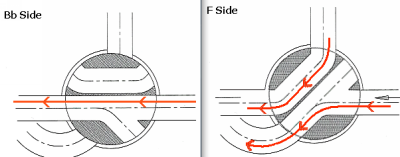
The drawings don't tell whether the airpath(-s) are in one single plane or whether there is some offsetting of planes in play. I only can imagine a proper alignment of ports, if the airpaths are in one and the same plane.
Does that imply that the Bb as well as the F airpaths have a dead end length of tubing while they pass through the rotor?
If so, why have inventors of alternative water keys worked hard to avoid the much smaller volumes of dead end tubing associated with traditional water keys?
In my interpretation the Lindbergh valve introduces a source of turbulence. A phenomenon not really liked in aviation nor in music.
Klaus


